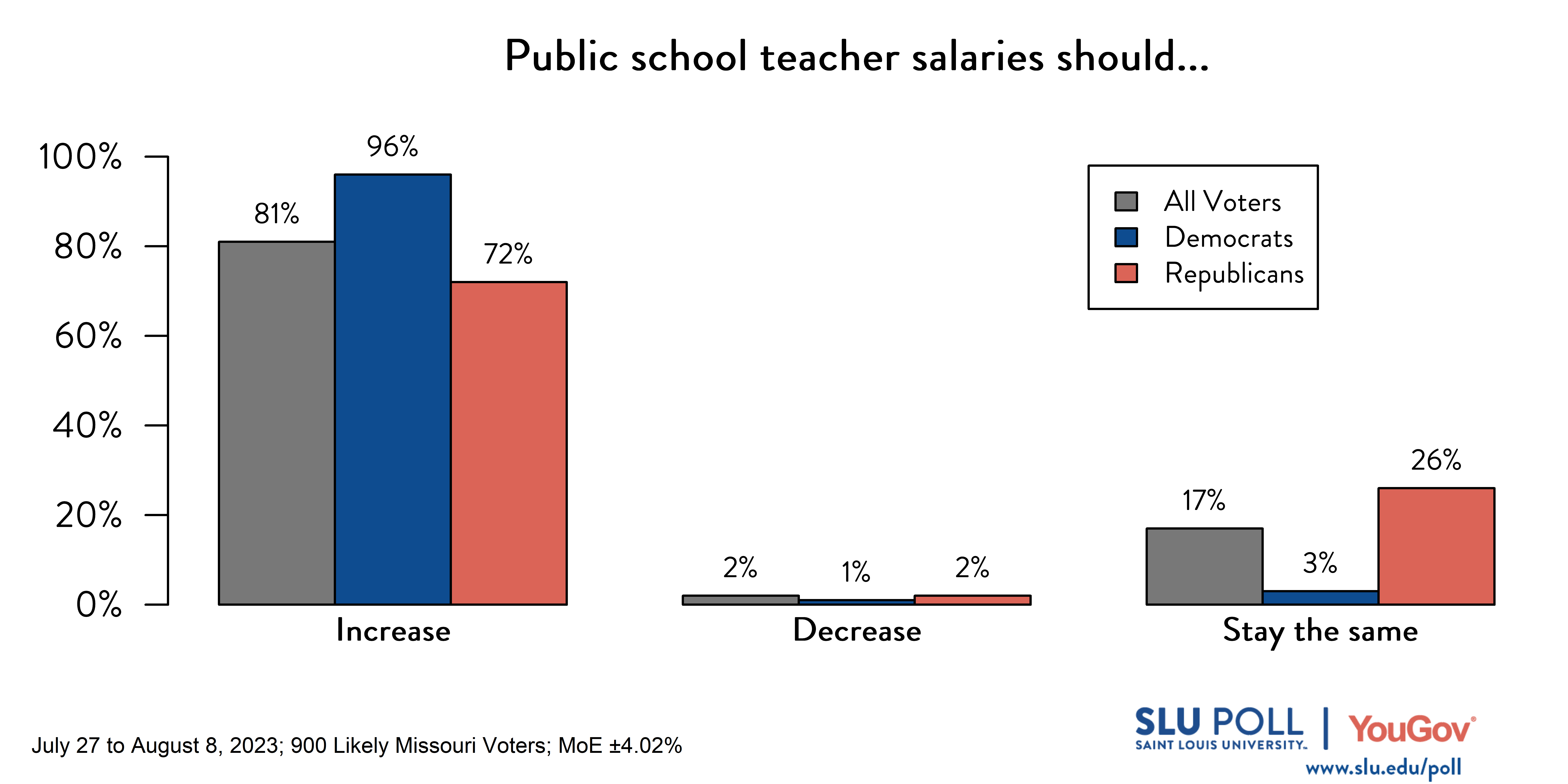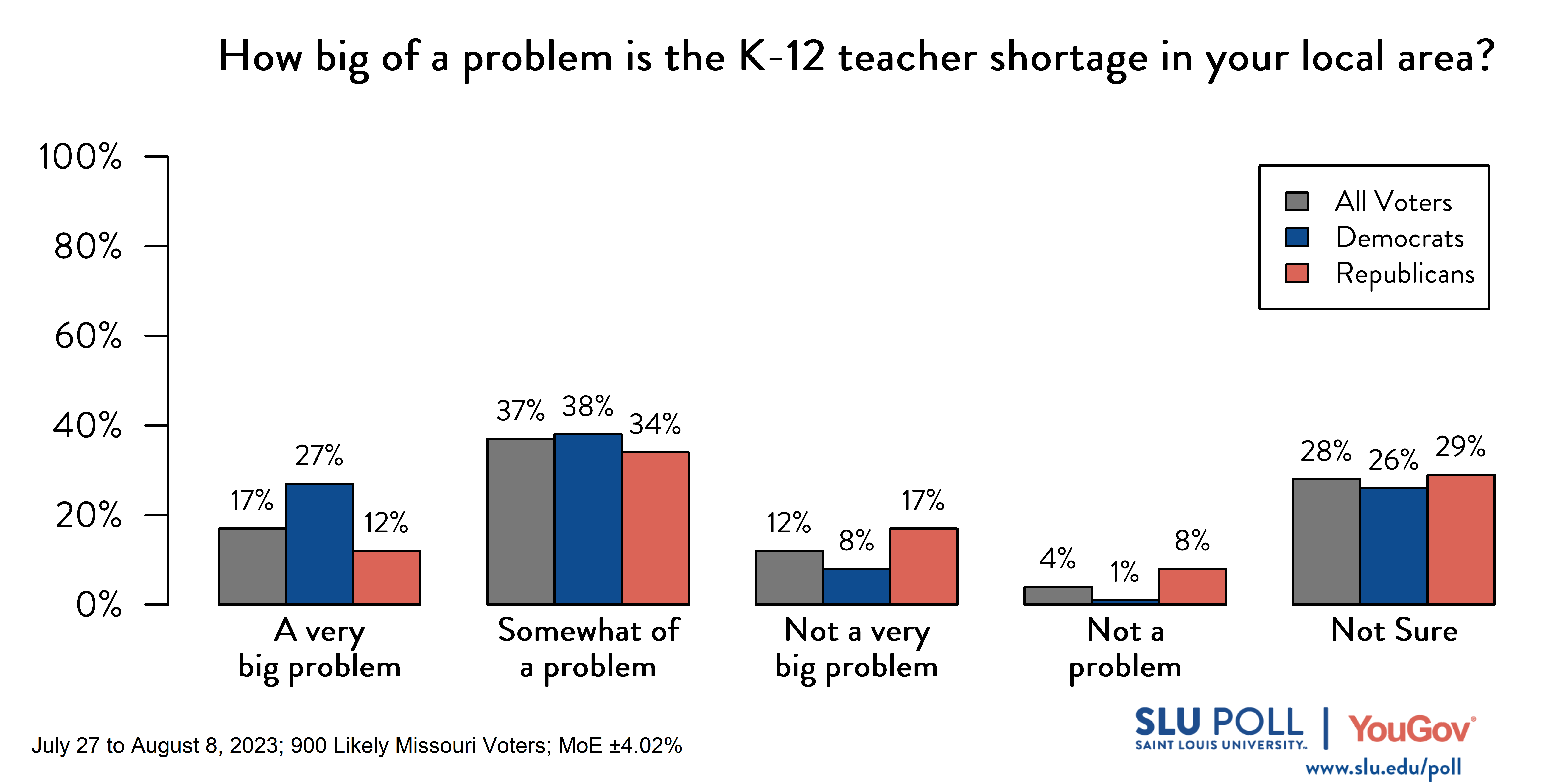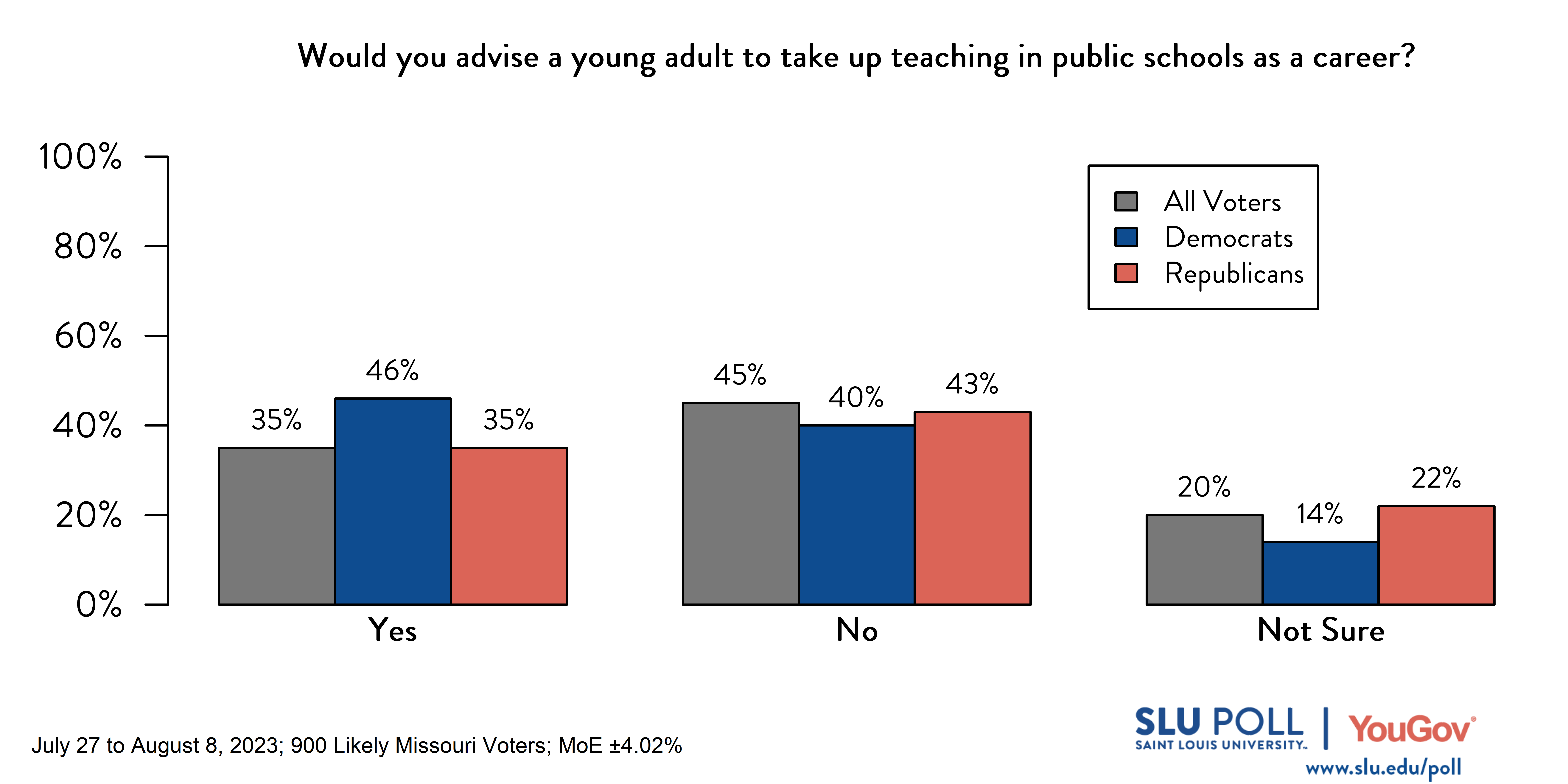SLU/YouGov Analysis: The Interconnectedness of Missouri’s Teacher Pipeline Woes
SLU's Ashley Donaldson Burle provides expert analysis on the latest results from the SLU/YouGov Poll as they pertain to a variety of education issues.
Missouri average starting teacher salaries are the second lowest in the nation (NEA, April 2023). By law, the minimum teacher salary in Missouri is $25,000. 25 of the state’s traditional and public charter school districts employed at least one teacher earning the state-mandated minimum (SLU PRiME Center, May 2022), and first-year Missouri educators earned just over $34,000 on average in the 2021-22 school year, ranking Missouri 50 out of 51 states and the District of Columbia (NEA, April 2023). Missouri’s 2021-22 average teacher salary was also among the lowest in the county—less than the average of all eight of Missouri’s neighboring states—at $52,481 (NEA, April 2023; SLU PRiME Center, June 2023). The SLU/YouGov August 2023 poll asked Missourians about their views on public teacher salaries. Results indicated that an overwhelming majority (81%) of Missouri voters support increasing teacher salaries. This result was strongly supported across all Missouri voter demographics, including gender, age, race and income, and all political party affiliations.
Missourians have repeatedly supported increasing starting teacher salaries; still, salary increases have only come through yearly budget allocations in the absence of a permanent legislative solution. Results from the August 2022 SLU/YouGov Poll found 71% of voters said they wanted to increase the minimum starting teacher salary from $25,000 to $38,000 permanently. The Teacher Baseline Salary Grant has been available for the past two years to aid districts in providing teachers with a standard salary of at least $38,000. Districts were required to provide 30% of the funding while the state provided the remaining 70% in the program’s first year; this school year, Governor Parson approved a budget eliminating the need for district support (St. Louis Public Radio, June 2023). The Missouri House of Representatives overwhelmingly (145-5) passed HB 497 in April 2023 to increase the minimum teacher salary from $25,000 to $38,000 (Missouri Independent, April 2023). The bill seemed sure to go to the Governor’s desk for approval, yet the bill fizzled, never making it to the Senate floor. Representative Ed Lewis (R-Moberly), who sponsored the legislation, stated, “This one was poised to go through right at the end, just before the Senate kind of fell apart for the last two weeks” (Missouri Independent, June 2023). Missouri lawmakers passed seven non-budget elementary-and-secondary-education bills affecting districts during the most recent legislative session, but many were disappointed and frustrated with the outcome of HB 497, which left starting teacher pay unchanged (Missouri Independent, June 2023).
Teacher Retention and Shortages
The connection between Missouri’s low teacher salaries and issues with teacher recruitment and retention has been underscored by the State Board of Education’s Teacher Recruitment and Retention Blue Ribbon Commission since 2022 (Missouri Independent, August 2022). Teacher retention was 88.1% in 2021-22, the lowest in the last six years (SLU PRiME Center, June 2023). The Commission wrote in a summary of its May 2023 meeting, “Missouri educators feel undervalued and under-supported, particularly in terms of pay for experienced educators” (KY3, June 2023). Low pay was explicitly cited as one of the reasons for teacher departure, contributing to Missouri’s teacher shortage (St. Louis Public Radio, May 2023).
Missouri has the equivalent of more than 3,500 full-time teacher vacancies (MO DESE, May 2023). Voters appear to be aware of the teacher shortage problem. Seventeen percent said it was “a very big problem,” while 37% indicated it was “somewhat of a problem.” These results show that a majority (54%) of Missourians believe the K-12 teacher shortage is a problem at some level. Results along party lines differed some from the overall results, with Democrats feeling more strongly than Republicans (27% vs. 12%) that teacher shortages are “a very big problem.”
Poll respondents were more divided on this issue by race. Thirty-eight percent of Black voters and 31% of all other non-white voters viewed teacher shortages as “a very big problem,” as opposed to 15% of white voters. Teacher shortages are a nationwide issue but have been found to occur commonly in the west, urban and rural communities, and in schools predominantly serving Black and Brown children (U.S. Government Accountability Office, August 2023). St. Louis Public Schools (SLPS) had 279 (15%) of its teacher positions unfilled in June (KMOV, June 2023), while rural towns like Chilhowee, Missouri—which employs 20 teachers total—also indicated being recently impacted by teacher shortages (KCTV5, August 2023). The August SLU/YouGov Poll results indicated urban voters (69%) were most likely to consider teaching shortages “a very big problem” or “somewhat of a problem,” followed by suburban (56%) and rural (55%) voters.
Missouri districts have employed other methods to address teacher shortages. Nearly a third of Missouri districts will be on a 4-day school week schedule this year (KY3, August 2023)—many citing teacher shortages as a motivation—but the February SLU/YouGov Poll found that only 34% of voters favor permanent four-day school weeks. Four-day school weeks are prevalent in rural districts. However, the Independence School District, one of Kansas City’s largest districts, is bucking this trend as they switch to a 4-day school week this school year (Fox4, August 2023). Missouri also recently passed a new law to tackle teacher shortages by encouraging retirees to return to the classroom (Missouri Independent, July 2023).
Missouri’s Teacher Pipeline and Views on Teaching as a Career
Missouri teachers are leaving the profession at a higher rate, and compounding the crisis is a lack of new teachers entering the pipeline. Missouri’s enrollment in teacher preparation programs increased between 2014-15 and 2020-21, yet completion of teacher preparation programs declined by 13% in the same period (SLU PRiME Center, 2023). The Missouri State Teachers Association (MSTA) reported that the number of Missouri college graduates who go through the process of becoming certified to teach has declined by 25-30% (St. Louis Public Radio, May 2023).
Amplifying this leak in the pipeline are views on the teaching profession as a career. A plurality of Missouri voters (45%) would not advise a young adult to take up teaching in public schools as a career. This result shows that many voters may not see teaching as a viable option for a career. Democrats were the most optimistic to recommend teaching as a career (46%), yet nearly as many (40%) indicated they would do the opposite.
In summary, the results of the August 2023 SLU/YouGov Poll suggest an interconnectedness between the woes of Missouri’s teacher pipeline. The teacher pipeline is leaking, creating shortages, some of which are a result of low teacher salaries. Voters strongly support increasing teacher salaries but, facing a lack of permanent increased pay, are not as likely to recommend teaching as a profession, despite recognizing a need for more teachers. The lack of strong opinions against teaching as a profession might be an opportunity for optimism in the face of declining numbers of students approaching teaching.
This analysis is based on data from the August 2023 SLU/YouGov poll and reflects the opinion of the author.




















